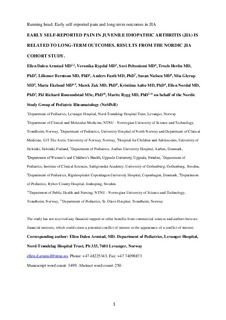| dc.contributor.author | Arnstad, Ellen Dalen | |
| dc.contributor.author | Rypdal, Veronika Gjertsen | |
| dc.contributor.author | Peltoniemi, Suvi | |
| dc.contributor.author | Herlin, T | |
| dc.contributor.author | Berntson, Lillemor | |
| dc.contributor.author | Fasth, Anders | |
| dc.contributor.author | Nielsen, Susan | |
| dc.contributor.author | Glerup, Mia | |
| dc.contributor.author | Ekelund, Maria | |
| dc.contributor.author | Zak, Marek | |
| dc.contributor.author | Aalto, Kristiina | |
| dc.contributor.author | Nordal, Ellen Berit | |
| dc.contributor.author | Romundstad, Pål Richard | |
| dc.contributor.author | Rygg, Marite | |
| dc.date.accessioned | 2019-01-07T16:23:22Z | |
| dc.date.available | 2019-01-07T16:23:22Z | |
| dc.date.created | 2019-01-07T11:04:35Z | |
| dc.date.issued | 2018 | |
| dc.identifier.issn | 2151-4658 | |
| dc.identifier.uri | http://hdl.handle.net/11250/2579546 | |
| dc.description.abstract | Objective
To study self‐reported pain early in the disease course of juvenile idiopathic arthritis (JIA) as predictor of long‐term disease outcomes.
Methods
Consecutive cases of JIA with disease onset 1997‐2000 from defined geographical areas of Norway, Sweden, Finland and Denmark were prospectively enrolled in this population‐based cohort study. Self‐reported, disease‐related pain was measured on a 10 cm visual analogue scale (VAS pain). Inclusion criteria were a baseline visit with pain score six months after disease onset, followed by an eight‐year study visit. Remission was defined according to Wallace preliminary criteria. Functional disability was measured by Childhood Health Assessment Questionnaire (CHAQ) and Child Health Questionnaire (CHQ‐PF50) if age <18 and Health Assessment Questionnaire (HAQ) if age ≥18 years. Damage was scored using the Juvenile Arthritis Damage Index (JADI).
Results
The final study cohort consisted of 243 participants, and 120 (49%) had oligoarticular onset. At baseline 76% reported VAS pain >0 compared to 57% at eight‐year. Half of those who reported baseline pain also reported pain at eight‐year, but at a lower intensity. Compared to no pain, higher pain intensity at baseline predicted more pain at eight‐year, more functional disability, more damage and less remission off medication. Baseline pain predicted more use of DMARDs/biologics during the disease course. Participants with oligoarticular JIA reporting pain at baseline were more likely to develop extended oligoarticular or other unfavorable JIA categories.
Conclusion
Early self‐reported, disease‐related pain among children and adolescents with JIA is common and seems to predict persistent pain and unfavorable long‐term disease outcomes. | nb_NO |
| dc.language.iso | eng | nb_NO |
| dc.publisher | Wiley | nb_NO |
| dc.title | Early self-reported pain in juvenile idiopathic arthritis (JIA) is related to long-term outcomes. Results from the Nordic JIA cohort study. | nb_NO |
| dc.type | Journal article | nb_NO |
| dc.type | Peer reviewed | nb_NO |
| dc.description.version | acceptedVersion | nb_NO |
| dc.source.journal | Arthritis care & research | nb_NO |
| dc.identifier.doi | 10.1002/acr.23715 | |
| dc.identifier.cristin | 1651332 | |
| dc.description.localcode | Locked until 28.7.2019 due to copyright restrictions. This is the peer reviewed version of an article, which has been published in final form at [https://doi.org/10.1002/acr.23715]. This article may be used for non-commercial purposes in accordance with Wiley Terms and Conditions for Self-Archiving. | nb_NO |
| cristin.unitcode | 194,65,15,0 | |
| cristin.unitcode | 194,65,20,0 | |
| cristin.unitname | Institutt for klinisk og molekylær medisin | |
| cristin.unitname | Institutt for samfunnsmedisin og sykepleie | |
| cristin.ispublished | true | |
| cristin.fulltext | postprint | |
| cristin.qualitycode | 2 | |
